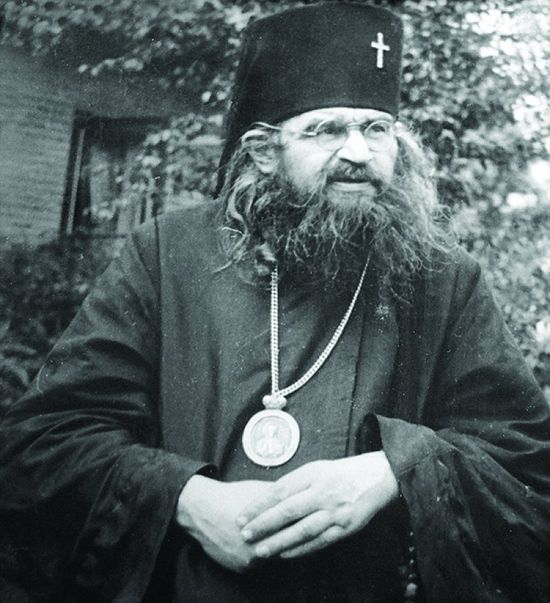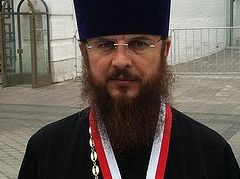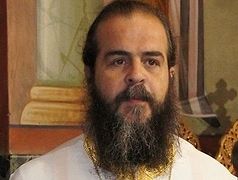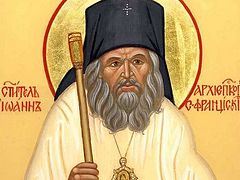The following article was written, as the title indicates, in response to recent remarks from Metropolitan Emmanuel of Gaul of the Patriarchate of Constantinople about St. John (Maximovitch), great among the saints. While the Metropolitan refers to the Holy Hierarch as a schismatic, he at least acknowledges his sanctity. On the other hand, in the past few weeks, a very public member of the Archons (the Order of St. Andrew the Apostle)—a group of laymen who act as defenders of the Patriarchate of Constantinople—who uses memes rather than reasoned dialogue to attack anyone who does not wholly follow the Constantinople party line on Ukraine or any other issue, has taken to blaspheming Christ through His saints, attacking the person of St. John and denying his sainthood with language and a spirit inappropriate for any Orthodox Christian. Thus, the present article is doubly relevant.
Much has already been said about the unfortunate events in the Church life of the much-suffering Orthodox people in Ukraine, and it seemed that the Patriarchate of Constantinople had already exhausted all its arguments to justify the unjustifiable. However, the representatives of Constantinople are now trying to prove that the “Russians” did the same thing in the past, they say, as they, Constantinople, are doing now.
What are we referring to? On the occasion of the patronal feast of the Greek cathedral in Paris, the representative of the Patriarchate of Constantinople in the French capital, Metropolitan Emmanuel of Gaul, stated:
The blessed union of ROCOR with the Moscow Patriarchate led to the restoration of this Church and its many souls in the bosom of the canonical Church. For almost a century, this Church was in schism. Schismatic bishops consecrated other bishops over the course of three or four generations. But the time came when the Moscow Patriarchate entered into full communion with them without hesitation in 2007, not questioning the Apostolic Succession of these hierarchs. Indeed, such a holy person as John (Maximovitch), who was born a schismatic, was consecrated to the episcopacy by schismatics, and died a schismatic, was recognized as a saint by the Moscow Patriarchate and is venerated by all of us today.
Having compiled, with God’s help, the biography of St. John, and moreover, having participated in the IV All-Diaspora Council in 2006, which laid the foundation for Eucharistic communion between ROCOR and the MP, I consider it my duty to tell the truth about the saint and about the restoration of Eucharistic communion between the Russian Church Abroad and the Russian Orthodox Church in 2007.
 Signing of the Act of Reunification of the Russian Orthodox Church Abroad with the Russian Orthodox Church-Moscow Patriarchate, May 17, 2007. Photo: S. Vlasov, V. Khodakov / patriarchia.ru
Signing of the Act of Reunification of the Russian Orthodox Church Abroad with the Russian Orthodox Church-Moscow Patriarchate, May 17, 2007. Photo: S. Vlasov, V. Khodakov / patriarchia.ru
1. Above all, the statement that a schismatic can be numbered among the saints is at least strange, because, according to the Holy Fathers, the sin of schism is not washed away even by martyr’s blood.
2. As for St. John (Maximovitch), the future hierarch was born in Adamovka, in the Kharkov Governorate of the Russian Empire, on the territory of modern Ukraine. At that time, there existed only one all-Russian Church: There was no ROCOR, nor even the Patriarchate of Moscow, which was restored, as we know, in 1917. To claim that St. John “was born in schism” is simply absurd.
3. But if St. John was not “born in schism,” then was he “consecrated to the episcopacy by schismatics?” As we know, Metropolitan Anthony (Khrapovitsky), formerly of Kiev and Galicia, the First Hierarch of ROCOR, led the consecration of St. John in Belgrade. Therefore, we need to clarify whether ROCOR was an organization like the “Kiev Patriarchate” or the “Ukrainian Autocephalous Orthodox Church,” now united, or rather—half-united in the “OCU.”
-
ROCOR was founded in 1920 on the basis of Decree No. 362 of His Holiness Patriarch Tikhon, the Holy Synod, and the Supreme Church Council of the Russian Orthodox Church—that is, the highest authority of the Russian Orthodox Church. This is the first difference between ROCOR and the Ukrainian schism: All of the ROCOR hierarchs had canonical consecrations and created their ecclesiastical body with the blessing of the Church authorities, while Philaret Denisenko and Makary Maletich did not obey the Church hierarchy and created a schism. Moreover, Makary and those with him have their “succession” from the impostor Vincent Chekalin, so they, and not the bishops of ROCOR, do not have Apostolic Succession. This is the first and most important difference.
-
However, later, in 1934, the Locum Tenens of the Moscow Patriarchal Throne Sergius (Stragorodsky), under enormous pressure from the godless authorities, suspended Metropolitan Anthony (Khrapovitsky) and seven hierarchs abroad, although, as the famous canonist S. V. Troitsky wrote at the time, “not a single Orthodox Church paid attention to his (Metropolitan Sergius’) prohibition and did not interrupt communion with the Russian hierarchs abroad,” based on the view that this prohibition was not an expression of the free will of Metropolitan Sergius.
It is also interesting how the Moscow Patriarchate itself and the Constantinople Patriarchate treated this suspension. Regarding the MP, it is enough to recall that Patriarch Alexei I himself served a panikhida at the grave of Metropolitan Anthony (Khrapovitsky) in Belgrade in 1957. Would the Patriarch have served a panikhida for a “schismatic?”
And what was Constantinople’s attitude to the foreign “schismatics” until recently? Here are just two examples, although there are many more:
In 1964, Bishop Dionysius (Psiahas) of the Patriarchate of Constantinople in Australia took part in the nomination of Archimandrite Philaret (Voznesensky), the future First Hierarch of ROCOR, as Bishop of Brisbane. And in the 1960s, the future Ecumenical Patriarch Bartholomew, then a young deacon and student of the Pontifical Oriental Institute, concelebrated with a ROCOR hierarch in the ROCOR parish in Rome.
And most importantly: From the beginning of the Synod Abroad’s stay in Yugoslavia in 1921 until the canonical act, ROCOR was in Eucharistic communion with the Serbian Orthodox Church, as evidenced by the fact that Metropolitan Amfilohije of Montenegro, with the blessing of Patriarch Alexei II, participated in the IV All-Diaspora Council and concelebrated with the ever-memorable Metropolitan Laurus in San Francisco, a year before the canonical act of 2007. This means ROCOR was always in communion with the Universal Church. Was there anything similar with the Ukrainian schismatics? This is the second difference. -
And the third difference: Even if the suspension was canonical, the hierarch remains a hierarch; with a defrocking—as in the case of the former Metropolitan Philaret Denisenko—the hierarch is deprived of Divine grace, as are all his “ordinations.”
-
There is a fourth difference, no less significant. Metropolitan Emmanuel, as well as the Ecumenical Patriarch, endlessly repeat that their intention was to return the Ukrainian schismatics to communion with the Universal Church, and this would have been laudable. But the question is this: According to the Holy Fathers, even something good done in a not good way is not good. To this St. Justin (Popovic) added: “Not like the Jesuits, for whom the ends justify the means.” In this respect, it is interesting to consider how, on the one hand, the reunion of the MP and ROCOR in 2007 happened, and how, on the other, the so-called “unification council” in Kiev in 2018 happened.
The first important step towards the reunification of the MP and ROCOR was the convocation of the IV All-Diaspora Council in San Francisco in 2006. At the insistence of the ever-memorable First Hierarch of ROCOR Metropolitan Laurus, all “parties” were to be represented at it, including those opposed to reunion, of which there were not a few. Therefore, after a long discussion at the Council, the sides could not come to an agreed-upon decision. Then suddenly the priests who were members of the editorial board of the Council’s appeal, recalled the miracle of the holy Great Martyr Euphemia, when the Orthodox holy hierarchs and their opponents wrote their confessions of faith on separate scrolls and placed them in the tomb of the holy Great Martyr Euphemia. Three days later, the Patriarch opened the reliquary: St. Euphemia was holding the scroll with the Orthodox confession in her right hand, and the heretical scroll lay at her feet… It was the same at the All-Diaspora Council: The priests laid the draft of the Council’s appeal with a request to the hierarchy of ROCOR to enter into Eucharistic communion with the MP on the holy relics of St. John and served a moleben before his relics with the commemoration by name of every participant in the Council. The next day, to everyone’s surprise, the appeal was unanimously adopted by all.
It is not by human efforts and ideas, but by the grace of God, that the unity of the Church is achieved when it is destroyed by the primordial enemy of the salvation of mankind. The Holy Spirit Himself accomplishes unity, not us. The fruit of the canonical act of 2007 was not just the reunification of the Russian Orthodox Church, but the joy of the entire Orthodox world and the unanimity of holy Churches of God on this occasion.
In contrast to the All-Diaspora Council, the “unification council” in Kiev gathered only two canonical hierarchs and all the schismatics, and its final result was simply a fiasco: The situation continues until today in Ukraine. Moreover, the “honorary Patriarch” Philaret restored his “Kiev Patriarchate” with several “hierarchs.” It is clear that the Holy Spirit is absent in all this history, for He “welds together,” not dispersing “the whole institution of the Church.” Unlike the canonical act of 2007, the “tomos” sowed confusion, discord, and schism in the entire Orthodox world, including within the Greek and Alexandrian Churches, which—non-synodally—recognized the “OCU.” Ye shall know them by their fruits. Do men gather grapes of thorns, or figs of thistles? (Mt. 7:16). -
One more difference: ROCOR didn’t pursue “with fire and sword” those few communities that didn’t accept the canonical act, although it could have filed civil suits to have the churches taken from it returned. But in Ukraine, everyone knows the nearly daily seizures of churches of the canonical Church (with the complete silence of Constantinople and the Western “democracies”). Thus, their methods are different.
4. Let us return now to St. John, “venerated by all of us,” in the words of Metropolitan Emmanuel. What was his view on the policy of the Ecumenical Throne? In his report at the II All-Diaspora Council in 1938, St. John decisively protested against the neo-papist actions of Constantinople, including in Russia, and said the following as if prophetic words:
The vicar of Metropolitan Evlogy in Paris, who was consecrated with the permission of the Ecumenical Patriarch, has assumed the title of Chersonese, as if Chersonese, which is now in the territory of Russia, is subject to the Ecumenical Patriarch. The next logical step for the Ecumenical Patriarchate would be to declare the whole of Russia as being under the jurisdiction of Constantinople.
To the deep chagrin of all who love the Church, these words came true.
5. From the above, it is clear that the Moscow Patriarchate entered into communion with the hierarchs of ROCOR in 2007 with the consciousness that the latter were canonically consecrated and were not schismatics, and not “with a simple signature,” as, unfortunately, Constantinople acted in regard to the self-consecrated—that is, without Apostolic Succession—and canonically defrocked “hierarchs” in Ukraine.
Instead of all kinds of justifications, “the foremost of the Orthodox Churches,” in the words of St. John (Maximovitch), headed by its Patriarch, “whose belittling can in no way be allowed,” as Metropolitan Anthony (Khrapovitsky) said about it, could have heard the voice of the numerous archpastors, pastors, and laity of nearly every Local Church and called a true Ecumenical Council with all the canonical hierarchs of the Church of Christ. This Council, as the hierarch of the Church of Constantinople Archbishop George (Wagner) of Evdokias expressed it at one time, could have become a second Council of Trullo, which standardized and supplemented Church norms. In this case, such a Council could not only have resolved the Ukrainian issue in the Holy Spirit, but also synodally clarified the disputed meaning of the 28th canon of the Fourth Ecumenical Council and thus determined what rights the See of Constantinople holds and what it does not. Then, as St. John said, “Such an outward abasement [by the Turks] of the hierarch of the city of St. Constantine, which was once the capital of the ecumene, [would] not [have] caused reverence toward him to be shaken among Orthodox Christians, who revere the See of Sts. Chrysostom and Gregory the Theologian.” Otherwise, if the present situation continues, we will fall under the condemnation of the words of the holy apostle Paul: The name of God is blasphemed among the Gentiles through you (Rom. 2:24).





